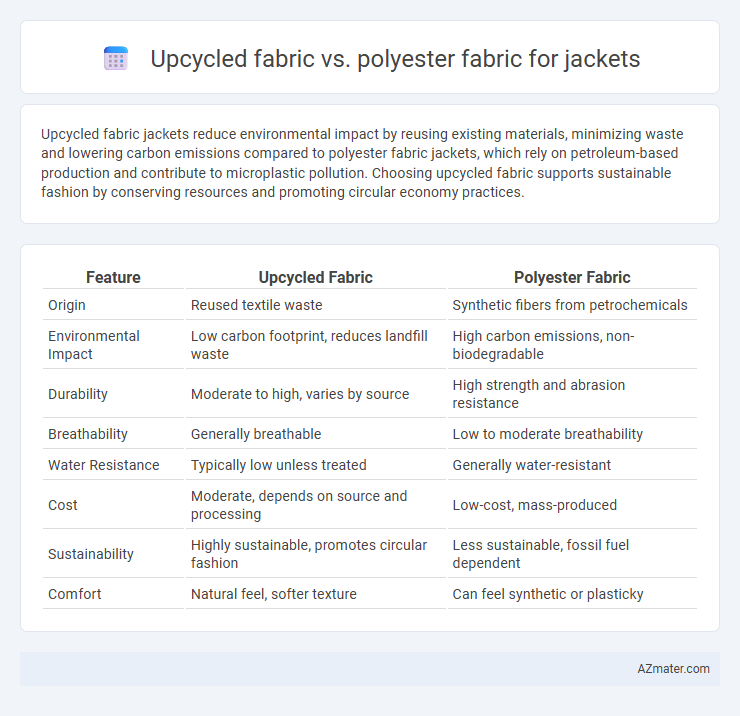Upcycled fabric jackets reduce environmental impact by reusing existing materials, minimizing waste and lowering carbon emissions compared to polyester fabric jackets, which rely on petroleum-based production and contribute to microplastic pollution. Choosing upcycled fabric supports sustainable fashion by conserving resources and promoting circular economy practices.
Table of Comparison
| Feature | Upcycled Fabric | Polyester Fabric |
|---|---|---|
| Origin | Reused textile waste | Synthetic fibers from petrochemicals |
| Environmental Impact | Low carbon footprint, reduces landfill waste | High carbon emissions, non-biodegradable |
| Durability | Moderate to high, varies by source | High strength and abrasion resistance |
| Breathability | Generally breathable | Low to moderate breathability |
| Water Resistance | Typically low unless treated | Generally water-resistant |
| Cost | Moderate, depends on source and processing | Low-cost, mass-produced |
| Sustainability | Highly sustainable, promotes circular fashion | Less sustainable, fossil fuel dependent |
| Comfort | Natural feel, softer texture | Can feel synthetic or plasticky |
Introduction to Upcycled and Polyester Fabrics
Upcycled fabric, created by repurposing pre-existing textiles, reduces waste and environmental impact while offering unique textures and designs for jackets. Polyester fabric, a synthetic material derived from petroleum, is valued for its durability, wrinkle resistance, and moisture-wicking properties in jacket manufacturing. Choosing between upcycled and polyester fabrics involves balancing sustainability goals with performance and cost considerations.
Environmental Impact: Upcycled Fabric vs Polyester
Upcycled fabric significantly reduces environmental impact by repurposing existing materials, minimizing waste, and decreasing the demand for virgin resources compared to polyester fabric. Polyester production relies heavily on non-renewable petroleum, contributing to greenhouse gas emissions and microplastic pollution during washing. Choosing upcycled fabric for jackets supports circular fashion practices and lowers carbon footprint relative to conventional polyester options.
Production Process and Resource Usage
Upcycled fabric for jackets utilizes reclaimed textile waste, significantly reducing the need for virgin materials and minimizing landfill contributions, resulting in a lower carbon footprint compared to polyester fabric, which is derived from petroleum through energy-intensive processes. The production of polyester fabric involves high water consumption and the release of microplastics into the environment during washing, whereas upcycled fabric production typically requires less energy and water since it repurposes existing materials. Choosing upcycled fabric supports circular fashion practices by conserving resources and decreasing environmental impact associated with synthetic fiber manufacturing.
Durability and Longevity of Jackets
Upcycled fabric jackets often exhibit enhanced durability as they repurpose high-quality materials originally designed for prolonged use, resulting in sturdy and resilient garments. Polyester fabric, known for its resistance to stretching and shrinking, offers longevity through its ability to withstand frequent wear and washing without losing shape or color. Both materials provide durable options, but upcycled fabrics contribute an eco-friendly aspect while maintaining robustness comparable to polyester in jacket construction.
Comfort and Breathability Comparison
Upcycled fabric jackets offer superior breathability and enhanced moisture-wicking properties compared to polyester fabric, making them more comfortable for extended wear. Polyester jackets tend to retain heat and trap moisture, potentially causing discomfort during active use or in warm conditions. Choosing upcycled fabrics supports sustainability while delivering lightweight, breathable comfort ideal for everyday jackets.
Style and Aesthetic Versatility
Upcycled fabric offers a unique, one-of-a-kind aesthetic with varied textures and patterns that enhance the individuality of jackets, appealing to sustainable fashion enthusiasts and trendsetters alike. Polyester fabric provides a sleek, uniform appearance with vibrant color retention and smooth finishes, making it ideal for modern, streamlined jacket designs. While upcycled fabric emphasizes eco-conscious style and artisanal charm, polyester excels in delivering consistent aesthetic versatility for mass-produced, stylish outerwear.
Cost and Market Availability
Upcycled fabric for jackets offers a sustainable alternative with moderate costs influenced by sourcing and production scale, often available through niche or eco-conscious retailers. Polyester fabric is widely available and typically lower in cost due to mass production and synthetic manufacturing processes. Market availability of polyester ensures easier access and variety, whereas upcycled fabrics cater to growing demand in eco-friendly fashion markets with limited but expanding distribution.
Maintenance and Care Requirements
Upcycled fabric jackets require gentle washing methods, often cold water and mild detergents, to preserve the integrity of repurposed fibers and prevent damage. Polyester jackets offer easier maintenance, as they are typically machine washable, quick-drying, and resistant to shrinking and wrinkling. Both fabrics benefit from air drying to maintain shape, but polyester is more resistant to stains and fading under frequent use compared to upcycled fabric.
Ethical and Social Considerations
Upcycled fabric for jackets reduces textile waste and lowers environmental impact by repurposing existing materials, promoting sustainable fashion practices and supporting circular economy principles. Polyester fabric, often derived from petrochemicals, contributes to environmental pollution and microplastic contamination, raising concerns about its ethical sustainability and long-term ecosystem effects. Choosing upcycled materials enhances social responsibility by encouraging fair labor practices and reducing reliance on resource-intensive synthetic production.
Choosing the Right Fabric for Your Jacket
Upcycled fabric offers an eco-friendly choice for jacket construction, utilizing recycled materials that reduce environmental impact while often providing unique textures and durability. Polyester fabric is prized for its lightweight, water-resistant properties and longevity, making it a practical option for weather-resistant jackets. Selecting the right fabric depends on prioritizing sustainability with upcycled options or performance features such as moisture-wicking and durability found in polyester.

Infographic: Upcycled fabric vs Polyester fabric for Jacket
 azmater.com
azmater.com